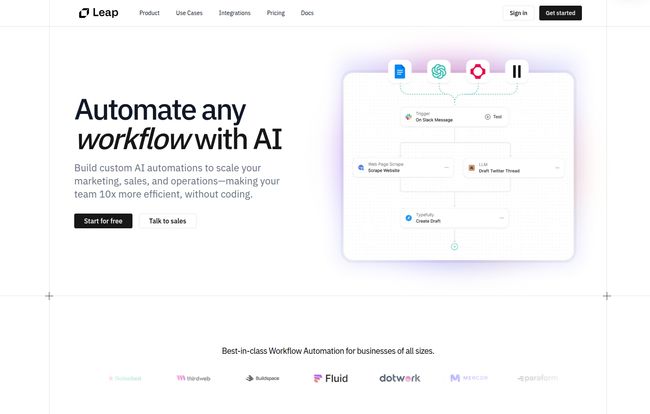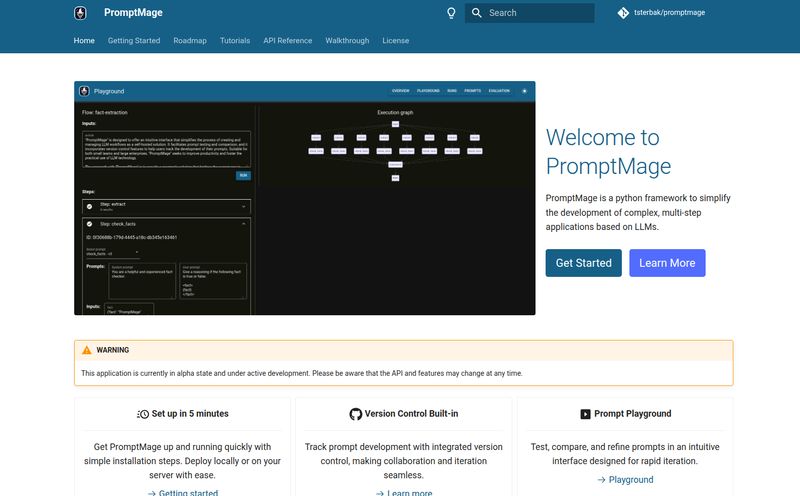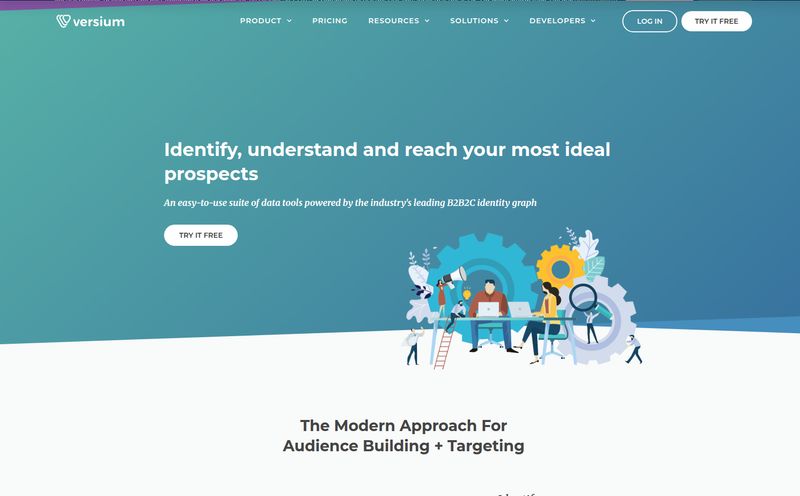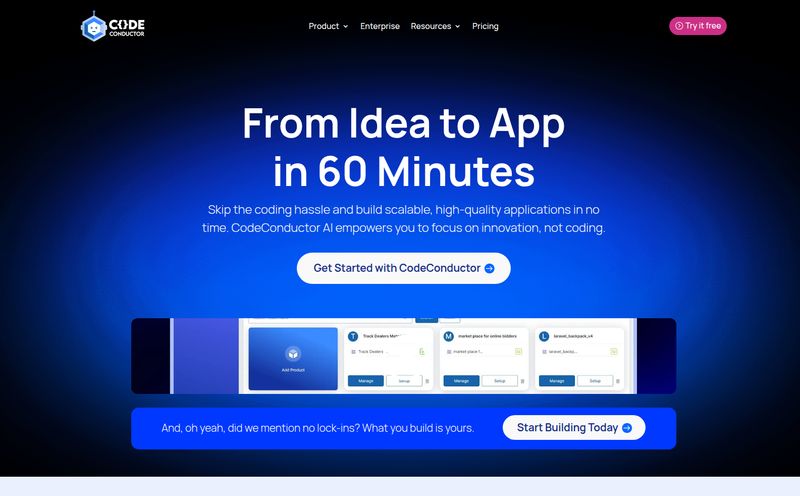If you're in marketing, SEO, or really any digital-first role, you know the grind. That endless loop of tasks that are important, but oh-so-draining. Pulling data for reports, repurposing a blog post into twenty social snippets, chasing down new leads with a personalized-but-not-really-personalized email... it’s a time suck. For years, we’ve been promised that automation would be our savior, and tools like Zapier or Make certainly moved the needle. They’re great. But they always felt like they were missing a piece of the puzzle—the 'thinking' part.
Then AI exploded onto the scene, and suddenly, the game changed. Now we're talking about not just connecting apps, but building intelligent workflows. That’s the promise of platforms like Leap AI, a tool that's been making some noise. The big claim? Letting small teams achieve the efficiency of massive companies by building custom AI automations without writing a single line of code. Sounds good, right? Almost too good. So, I decided to pop the hood and see if it's all marketing fluff or the real deal.
So, What Exactly Is Leap AI, Anyway?
Think of it like this: Leap AI is what you'd get if Zapier and a team of eager, trainable AI assistants had a baby. It's a platform designed to let you build 'workflows' that link your various tools together (your CRM, your email marketing platform, Google Sheets, etc.) and inject AI-powered actions into the process. And the best part for most of us? It’s a no-code platform.
This isn't about learning Python or wrestling with APIs directly. It’s about dragging, dropping, and visually connecting blocks to build a process. For example, instead of just 'When a new lead comes in from Facebook Ads, add them to a spreadsheet,' you can build something like, 'When a new lead comes in, have an AI research their company, draft a personalized outreach email based on their industry, and then add them to the spreadsheet with the draft email attached for my review.' See the difference? It’s not just automation; it's automation with a brain.
It’s aimed squarely at marketing, sales, and operations teams who are trying to scale without a massive headcount. The kind of people who know what they want to do but don't have a developer on speed dial.

Visit Leap AI
My First Impressions: Getting Started with Leap AI
Logging in for the first time, I felt that familiar mix of excitement and 'okay, where do I even start?'. The biggest relief was seeing the pre-built templates. This is huge. Instead of staring at a blank canvas and having an existential crisis about workflow logic, you can pick a starting point like 'Automate Customer Feedback Analysis' or 'Automate Research and Documentation'. This immediately lowers the barrier to entry.
My mind, of course, went straight to SEO and content. Could I build a workflow to take a new blog post, have AI generate 10 unique tweets, a LinkedIn summary and maybe even a short script for a TikTok video? The integration list, which boasts over 300 tools, suggests... yes. All the usual suspects are there, which is critical. A workflow tool is only as strong as its connections.
Now, let's be honest. The 'potential learning curve' is a real thing. While it’s no-code, it's not no-thought. You still need to understand the logic of what you’re building. You need to think like a process manager. It’s not a magic button, but it's a hell of a lot more accessible than the alternative. It took me a bit of clicking around to really grasp how the triggers and actions chain together, but once it clicked... oh boy. The possibilities started to feel endless.
The Features That Actually Matter to a Marketer
You can read a feature list anywhere. Let's talk about what these things actually mean for our day-to-day work.
The No-Code Workflow Builder is Not Just for Devs
This is the core of Leap AI. The visual builder feels less like coding and more like putting together a puzzle or building with LEGOs. You pick a trigger (e.g., 'New Row in Google Sheet'), then add an action (e.g., 'Use AI to Write a Blog Intro'), then another action (e.g., 'Post to WordPress Drafts'). Seeing it all laid out visually makes complex processes so much easier to understand and troubleshoot. This democratization of automation is something I've been waiting for for a long time.
Those Pre-Built Templates Are Your Best Friend
I can't stress this enough. The templates are your jumpstart. They're not just for show; they're genuinely useful starting points that you can customize. Think about creating a knowledge base, generating leads, or even running a full-blown campaign. Instead of starting from scratch, you're modifying something that already works. It saves hours, maybe even days, of setup time and head-scratching.
A Massive List of Integrations
An automation tool without integrations is like a car without wheels. It might look cool, but it’s not going anywhere. Leap AI's ability to connect with over 300 tools is what makes it so powerful. It means you can likely plug it directly into your existing tech stack—whether you're using Slack, HubSpot, Google Drive, Airtable, or a host of other platforms. This is what lets you build truly end-to-end automations instead of having frustrating gaps in the chain.
Let's Talk Money: A Breakdown of Leap AI's Pricing
Okay, the all-important question: what’s this going to cost me? The pricing structure is refreshingly straightforward, which I appreciate. They have three main tiers.
| Plan | Price | Who It's For |
|---|---|---|
| FREE | $0 / month | The curious individual or solo-preneur. You get limited runs per month, which is perfect for testing the waters and proving the concept for a specific task. You can defintely build a useful workflow or two to see if you like it. |
| PRO | $99 / month | The sweet spot for most small businesses, agencies, and serious marketers. The unlimited workflow runs is the key here. This is the plan where you can really start offloading significant chunks of your workload to the platform. |
| BUSINESS | Custom | The big leagues. This is for larger teams that need custom integrations, dedicated support, an SLA, and the ability to run many automations at once. If you need a dedicated solutions engineer, this is your tier. |
My take? The free plan is genuinely useful for validation. The Pro plan's price might make some people pause, but if you calculate the cost of the man-hours it could save... it probably pays for itself very quickly. How much is 10, 20, or 30 hours of your team's time worth each month?
The Good, The Bad, and The AI-Powered
No tool is perfect. Let's get into the nitty-gritty. The biggest advantage, hands down, is putting the power of AI automation into the hands of non-developers. It’s an incredible force multiplier, allowing a small team to punch way above its weight class. It feels like you've suddenly hired a whole team of junior assistants who work 24/7.
On the flip side, let's be real about the 'cons'. The reliance on AI means you still need human oversight. AI can be... weird sometimes. It can hallucinate facts or produce slightly off-brand copy. You can't just set it and forget it entirely, at least not for client-facing tasks. It’s an assistant, not a replacement for a seasoned professional. You still need a human to review and approve the important stuff.
And yes, that learning curve. It's not steep like a mountain, more like a challenging hill. You need to be willing to spend a few hours tinkering and testing. If you're expecting a one-click solution to all your problems, you'll be disappointed. But if you're willing to invest a little time upfront, the payoff is massive.
My Verdict: Is Leap AI Worth It for Your Business?
After spending some time with it, my answer is a resounding yes, for the right kind of business. If you are a marketer, a salesperson, an agency owner, or an operations manager and you constantly feel like you're drowning in repetitive tasks that require a bit of 'smarts,' then Leap AI could be a game-changer for you.
Who is it NOT for? Maybe a huge enterprise that already has a team of developers building custom internal tools. Or, a very small business whose needs are fully met by simpler, non-AI automation tools. For everyone in between—that massive segment of ambitious, growing businesses—Leap AI feels like a perfect fit.
Final Thoughts
We're at a fascinating point in the history of digital work. For the first time, truly intelligent automation is accessible to everyone, not just corporations with bottomless budgets. Tools like Leap AI are at the forefront of this shift. It’s not just about saving time; it's about freeing up our human brains to focus on strategy, creativity, and the big-picture ideas that AI can't replicate. At least, not yet. What a time to be in marketing, eh?
Frequently Asked Questions
- Do I need to know how to code to use Leap AI?
- Absolutely not. Leap AI is a no-code platform built with a visual, drag-and-drop interface. If you can map out a process on a whiteboard, you can build it in Leap AI.
- What kind of tools can Leap AI integrate with?
- It integrates with over 300 popular tools used in marketing, sales, and operations. This includes things like Google Workspace (Sheets, Docs), Slack, Airtable, HubSpot, WordPress, and many others.
- Is the Free plan actually useful?
- Yes, it's very useful for testing and validation. The number of runs is limited, so you can't automate your entire business on it, but it's more than enough to build a few key workflows and prove its value before considering an upgrade.
- Can I bring my own API keys, like for OpenAI?
- Yes! All plans, including the Free one, allow you to 'Bring Your Own API Keys'. This is a great feature that gives you more control and can sometimes be more cost-effective if you already have accounts with services like OpenAI.
- How is Leap AI different from Zapier or Make?
- While Zapier and Make are fantastic for connecting apps (A triggers B), Leap AI adds a layer of artificial intelligence into the workflow. It's not just about data transfer; it's about data transformation, content creation, and analysis within the automation itself.
- Is my company's data safe with Leap AI?
- Data security is a major concern with any new tool. Leap AI, like most reputable SaaS companies, has security protocols in place. For businesses with strict compliance needs, the Business plan offers SLAs and premium support which typically cover more advanced security and data handling assurances.



